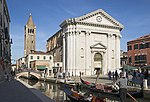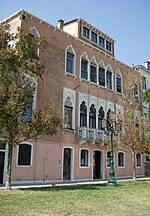Palazzo Clary
Clary und AldringenPalaces in Sestiere DorsoduroVenetian Gothic architecture

The Palazzo Clary (Clary Palace ) is a Late Renaissance Venetian palace facing the Giudecca Canal alongside the fondamenta Zattere by the ponte longo in Venice's Dorsoduro. It was originally built in the 17th century for a Venetian noble family. In the early 19th century, the palazzo is known as Palazzo Clary, named after it was bought by the prince Clary-Aldringen. The neighboring building is Palazzo Giustinian Recanati.
Excerpt from the Wikipedia article Palazzo Clary (License: CC BY-SA 3.0, Authors, Images).Palazzo Clary
Fondamenta Zattere al Ponte Longo, Mestre Venezia-Murano-Burano
Geographical coordinates (GPS) Address External links Nearby Places Show on map
Geographical coordinates (GPS)
| Latitude | Longitude |
|---|---|
| N 45.430197 ° | E 12.324483 ° |
Address
Palazzo Clary
Fondamenta Zattere al Ponte Longo
30170 Mestre, Venezia-Murano-Burano
Veneto, Italy
Open on Google Maps










